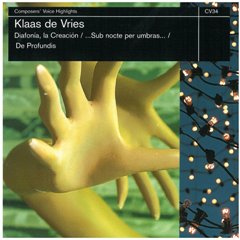Klaas De Vries - Diafonia, La Creacion - Sub Nocte Per Umbrae - De Profundis (1995)
Klaas De Vries - Diafonia, La Creacion - Sub Nocte Per Umbrae - De Profundis (1995)

1 – Diafonia, la Creacion - 17.01 Gerrie de Vries, Reina Boelens – soprano ASKO Ensemble David Porcelijn - conductor 2 - …sub nocte per umbras… 32.34 Schönberg Ensemble Reinbert de Leeuw – conductor 3 – De Profundis - 17.58 Symphonic Band of the Rotterdam Conservatorium Arie van Beek – conductor
Dutch composer (Terneuze, 1944). He studied the piano at Rotterdam Conservatory and continued his composition studies with Ketting at the Royal Conservatory in The Hague, winning the prize for composition there in 1974. He subsequently studied with Kelemen in Stuttgart. In 1972, he began to teach music and in 1979 was appointed to teach analysis, instrumentation and composition at Rotterdam Conservatory; in 1995 he was guest composer at the Tanglewood Festival of Contemporary Music. He was awarded the Matthijs Vermeulen Prize in 1983 for his orchestral Discantus.
De Vries is typical of postwar Dutch composers in his rejection of Expressionism and in his empirical approach, which has remained undogmatic and open to a variety of influences. Beginning from the immediacy of the late-Stravinsky-like Refrains for two pianos and orchestra (1968), his self-critical development has been one of action and reaction, both to his own work, in which more or less complex pieces alternate, and to impulses from outside: for example, early music in Organum (1971), minimalism in Moeilijkheden (‘Difficulties’) (1977), jazz in the trumpet solos of A King, Riding, or a specific composition, for instance Strauss’s Metamorphosen in Interludium (1977). His earlier ideal of an extrovert, objectified sound is brilliantly accomplished in works such as Follia (1973) and Discantus (1982) with their homogeneous blocks, elementary contrasts, montage-like forms and rhythmic physicality. In the following decade De Vries added a more inward-looking lyrical component, the basis for a family of ‘dream pieces’: … sub nocte per umbras … , Eclips, and the first part of the String Quartet of 1994, in which pale echos and fleeting references evoke a half-historical, half-mythical musical past.
The Sonata for piano (1987), inspired by the dramatic conflict between tradition and renewal in Mann’s Doktor Faustus, represents a turning-point. In subsequent works, De Vries has increasingly questioned the avant-garde belief in progress, without resorting to postmodern nostalgia. Under the influence of Borges and Stravinsky – whom he calls ‘fantastic liars’ – he has probed musical history and memory: for example, Diafonía, la creación (1989) results in ‘re-invented folk music’, while … sub nocte per umbras … (1989) employs a number of archetypal formulas and motifs, which, like the shadows of Vergil’s Aeneid to which the title refers, repeatedly return. (Together with De profundis these two works form part of an important trilogy.) A form of shadows plays a part too in Eclips (1992), an instrumental postscript which embarks from within the final reverberation of Skryabin’s piano work Vers la flamme and can only be performed with that piece. Debussy, Messiaen, Stockhausen and Boulez, present in the form of brief quotations, bear witness, in this reflective and essentially pessimistic essay-in-sound, to a view of a future which has become past.
Despite De Vries’s evolution in technique and style, certain elements have remained constant: his brilliant instrumentation, a flexible harmonic interplay between the chromatic and the diatonic, and a characteristic repertory of musical figures, of which the sustained note, the fanfare-like signal and the percussive rhythm are among the most notable. His most significant work, to date, is the ‘scenic oratorio’ A King, Riding, a summation of previous intellectual and technical concerns. Based upon Virginia Woolf’s The Waves, the work explores through seven characters – or seven parts of an autobiographical ‘I’ – his preoccupation with the question of identity, artistic and otherwise. ---New Grove Dictionary of Music
download (mp3 @320 kbs):
uploaded yandex 4shared mega mediafire solidfiles zalivalka cloudmailru oboom
